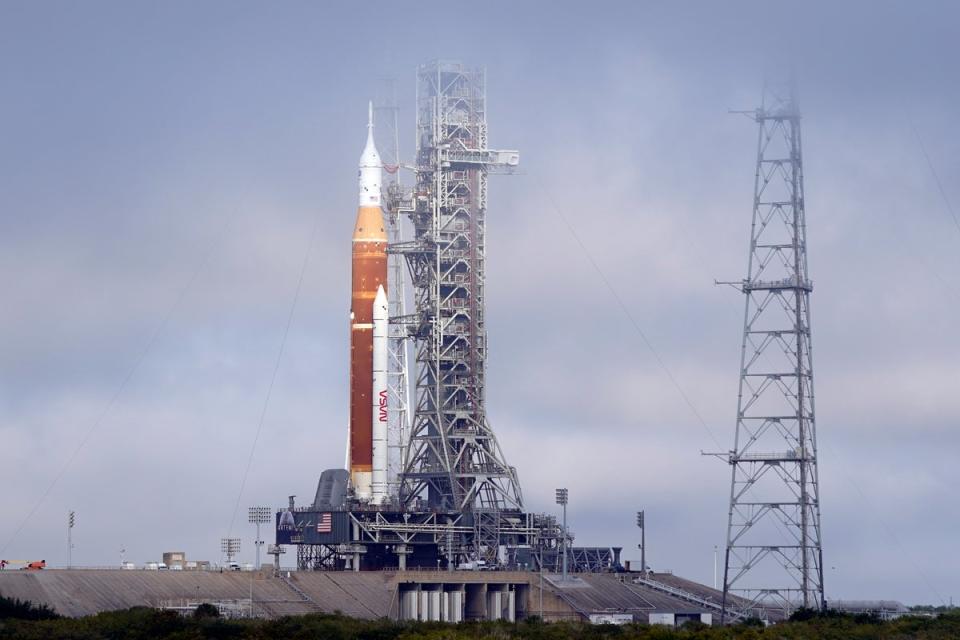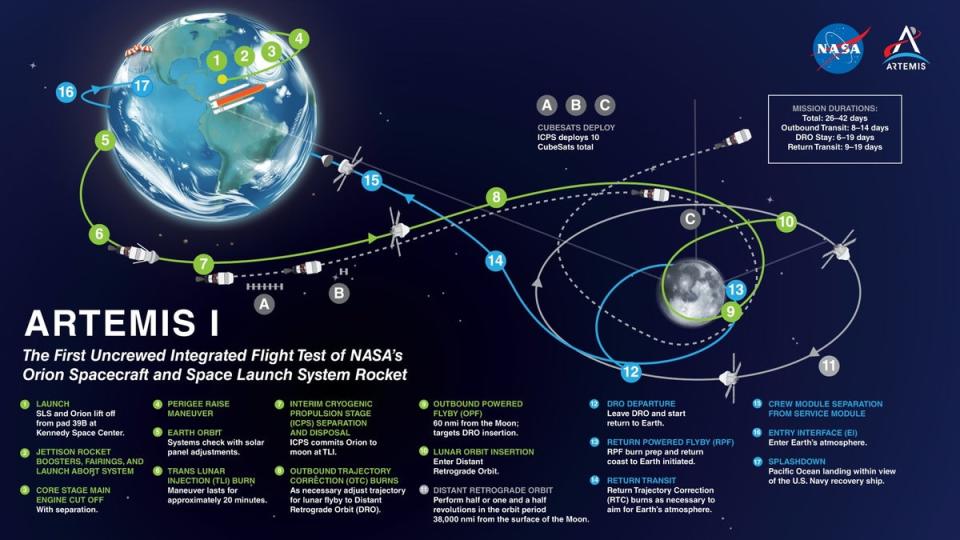Nasa’s Artemis 1 moon mission explained

Nasa’s Kennedy Space Center on the Florida coast may soon see its first launch of a massive Moon rocket since 1973, as the space agency prepares to launch its Artemis I mission as soon as 29 August.
An uncrewed test flight of Nasa’s Space Launch System rocket and the Orion spacecraft, Artemis I is Nasa’s first full test of hardware the agency hopes will put astronauts back on the Moon by 2025, and propel of a decade of lunar activities that will serve as a proving ground for technologies ultimately aimed at going on to visit Mars.
Here’s everything you need to know about the upcoming rocket launch and Nasa’s new Moon program for the 21st century.
When is the Artemis 1 launch and how can you watch it?
Artemis 1 is currently scheduled to lift off from launch complex 39B at Kennedy Space Center no earlier than 8.33am EDT on 29 August. The launch will be carried live on Nasa TV, the space agency’s website and the Nasa app.
If the launch is scrubbed for any reason, Nasa also has launch windows on 2 and 5 September, though Nasa officials have said they may launch the uncrewed test flight under some conditions that might ground a human crewed flight.
What is Artemis?
Nasa’s Moon program for the 21st century, Artemis will involve a progression of uncrewed and then crewed lunar flybys, culminating in the first human landing on the Moon in more than 50 years. The space agency then plans to fly crewed missions to the lunar surface once a year for the remainder of the decade, building a space station in lunar orbit and a base on the lunar South Pole where astronauts will test technologies and skills necessary for Nasa’s long term goal — a crewed mission to Mars in the early 2040s.
Following Artemis I, Artemis II will see a crew of astronauts make a lunar flyby in the spring of 2024. Artemis III, currently scheduled for sometime in 2025, will see the first astronauts, including the firstm woman and person of color, touch down on the lunar surface since 1972.
What is SLS?
Nasa’s Space Launch System, or SLS, is the largest rocket constructed since the Saturn V rocket of the Apollo program.
In its current configuration known as Block 1, SLS consists of a core booster field by liquid hydrogen and oxygen with two solid rocket boosters mounted on its sides reminiscent of the Space Shuttle, altogether capable of producing 8.8 million pounds of thrust. That’s about 15% more thrust than the Saturn V — when it launches on 29 August, SLS will be the most powerful rocket ever launched.
Together with the Orion spacecraft at its apex, SLS stands 322 feet tall, and can lift more than 90 tons into low Earth orbit. Together with the SLS Block 1 upper stage, known as the Interim Cryogenic Propulsion Stage, the launch system can deliver 27 tons of payload to the Moon.
What is Orion?
Orion is the Lockheed-Martin-built spacecraft Nasa selected to take astronauts back to the Moon for the Artemis program. It in many ways resembles the Apollo space capsule of the 1960s and 70s, but is slightly roomier — it can host four astronauts to Apollo’s three — and is built around modern computer and navigation technologies.
Like the Apollo capsule, Orion carries a heat shield in order to slow itself down through friction upon reentering the Earth’s atmosphere, and will use parachutes to slow itself down before splashing down in the Pacific Ocean.
What is the mission of Artemis I?
Artemis I is the first test flight for SLS and Orion, and a crucial test for making sure all of the rocket and spacecrafts’ systems will function properly in space before the first humans climb aboard for Artemis II in 2023.
Artemis I is a 42 day mission that will see SLS launch Orion toward the Moon. After a flyby that will take the spacecraft just 62 miles from the lunar surface, Orion will enter a wide orbit around the Moon for six days in order to collect flight data. The spacecraft will also carry three mannequins to help gather data on how the flight may affect the bodies and health of astronauts on the Artemis II and III missions.

The most crucial element of the mission will come at its end, when Orion re-enters the Earth’s atmosphere at 32 times the speed of sound, and puts its heat shield to the test for the first time. It’s the number one priority for the mission, according to Nasa officials.
“This is an ablative heat shield, and the only way you can test it is to get it out there and let it come in at 32 Mach,” Administrator Nelson said during a 3 August press conference. “Orion will come home faster and hotter than any spacecraft has before.”
After bleeding off speed in the form of heat, the Orion spacecraft’s parachutes will bring it down in the waters of the Pacific Ocean off the coast of Baja California at around 20 miles per hour.

 Yahoo Sports
Yahoo Sports 